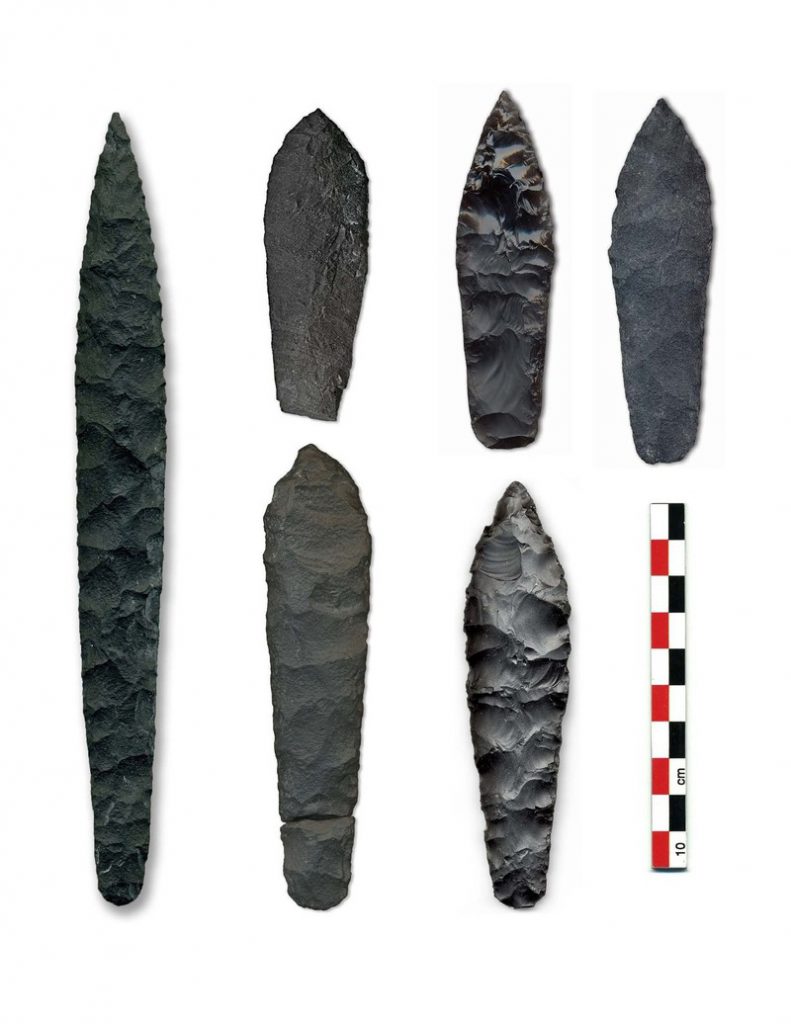by Daron Duke, Ph.D.
No one knows exactly when the first people arrived in Utah, but when they did, they saw a verdant and colorful version of what we know already to be a diverse and visually stunning landscape. They arrived near the end of a period of Earth’s history referred to by scientists as the Pleistocene, sometimes called the Ice Age for the massive ice sheets that covered much of Canada and the northern reaches of the United States. These ice sheets had largely melted by the time people entered Utah, but cooler temperatures, pine-lined valleys, and lake-filled lowlands offered great opportunities to peoples accustomed to hunting and gathering. Soon-to-be extinct megafauna such as mammoths, camels, and horses roamed Utah’s mountains, plateaus, basins, and wetlands with few predators.
Archaeologists have the first physical evidence for people in Utah by 13,000 years ago, which ushered in what they refer to as the Paleoindian Period. Fire hearths and stone tools in the caves and rock shelters of the west desert show people camping above a waning Lake Bonneville. As its deep waters receded, a vast marshland—today known as the Old River Bed delta—developed behind it in what is now the barren Great Salt Lake Desert. People used the delta for 3,000–4,000 years until it dried up and disappeared about 9,500 years ago.
The hallmark artifact for the earliest North American inhabitants is the Clovis projectile point. Clovis points are recognizable by their large size (4–6 inches in many cases), sophisticated craftsmanship, and a long channel flake or “flute” removed from each side. We know from sites east of the Rocky Mountains and in the deep Southwest that Clovis points were used to kill extinct kinds of elephants, such as mammoths and mastodons, as well as other large game like those still here today. Clovis points, and a similar later style called Folsom, can be found in Utah, but not as frequently as elsewhere.
Another signature style of projectile point in Utah is called Haskett (pictured below, Figure 1). Haskett points date to between 13,000 and 12,000 years ago and are argued by some archaeologists to be as old as Clovis but of a culture unique to western North America. At first glance, Haskett points look different than Clovis points, but they are also large, finely crafted, and made to hunt animals as big as mammoths. Haskett points are the earliest style in a series known as the Western Stemmed Tradition, and the smaller and more common stemmed points were used until about 9,500 years ago.
The people who used Haskett points were highly mobile. They moved their camps frequently and across long distances, as evidence by how far they traveled to get the obsidian glass that they used to make their tools. Archaeologists use the unique chemical signatures of obsidian sources like fingerprints to trace people’s movements across the landscape. Obsidian is common in western Utah, with some highly prized sources, such as Wildhorse Canyon near Cedar City, Topaz Mountain southwest of Dugway, and Browns Bench in Utah’s far north-western corner. Even farther sources of obsidian, such as Bear Gulch in Idaho near Yellowstone, were brought to Utah by people traveling hundreds of miles. These travels likely tracked large game’s seasonal movements and kept the sparse population of people socially connected.
Paleoindian-era people experienced significant environmental change as the climate warmed. The huge Ice Age animals were gone by 12,000 years ago, and Haskett and Clovis points stopped being used. The many valley wetlands that people had lived and hunted in began to dry up. Hunting became less critical than relying on plants and smaller animals, although the remaining marshes were still bountiful. What wetlands remained, such as the Old River Bed delta, were heavily occupied and used.
When even these marshes finally disappeared 9,500 years ago, people adjusted their priorities to suit an environment more like the one we see today. At the famous Danger Cave site, outside of Wendover, we know people began to use ground stone to process seeds as they shifted focus to the springs and uplands of the region where water remained, adapting their food choices to a warmer and dryer climate. They adapted to these changes with knowledge gained from their forebearers, the first Utahns.

